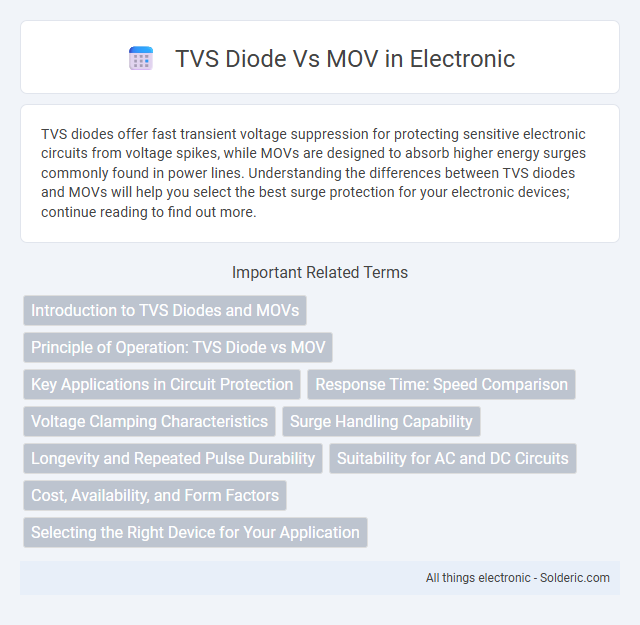TVS diodes offer fast transient voltage suppression for protecting sensitive electronic circuits from voltage spikes, while MOVs are designed to absorb higher energy surges commonly found in power lines. Understanding the differences between TVS diodes and MOVs will help you select the best surge protection for your electronic devices; continue reading to find out more.
Comparison Table
| Feature | TVS Diode | MOV (Metal Oxide Varistor) |
|---|---|---|
| Function | Transient Voltage Suppression | Surge Voltage Protection |
| Response Time | Nanoseconds (Fast) | Microseconds (Slower) |
| Clamping Voltage | Precise, Low | Less precise, Higher |
| Energy Absorption | Lower Energy Capacity | Higher Energy Capacity |
| Applications | Sensitive electronics, signal lines | Power lines, large surge protection |
| Failure Mode | Short circuit (fail-safe) | Open circuit or degraded |
| Lifespan | Limited by surge events | Degrades over time with surges |
| Cost | Higher | Lower |
Introduction to TVS Diodes and MOVs
TVS diodes and MOVs are essential components used to protect electronic circuits from voltage spikes and transient surges. TVS diodes offer fast response times and precise clamping voltage levels, making them ideal for sensitive semiconductor devices. MOVs handle higher energy surges with variable resistance characteristics but exhibit slower response and lower precision compared to TVS diodes.
Principle of Operation: TVS Diode vs MOV
TVS diodes operate by rapidly clamping voltage spikes through a semiconductor junction that changes from high impedance to low impedance when a threshold voltage is exceeded, offering precise and fast response to transient overvoltages. MOVs function by varying their resistance based on voltage; their metal oxide varistor material decreases resistance sharply during surges, absorbing excess energy to protect circuits. Your choice between TVS diodes and MOVs depends on the required clamping speed, energy absorption, and applications, with TVS diodes favored for fast, low-energy spikes and MOVs suited for higher energy transients.
Key Applications in Circuit Protection
TVS diodes excel in safeguarding sensitive electronic components from transient voltage spikes in high-speed data lines and power supply circuits, offering rapid response and precise clamping voltages. MOVs are commonly employed for bulk surge protection in AC power lines and industrial equipment, effectively handling high-energy surges but with slower response times and potential degradation over repeated events. Combining TVS diodes and MOVs in circuit protection designs enhances overall system reliability by addressing both fast transient events and sustained voltage surges.
Response Time: Speed Comparison
TVS diodes exhibit significantly faster response times, typically in the picosecond to nanosecond range, enabling rapid suppression of voltage spikes. Metal oxide varistors (MOVs) have slower response times, usually in the microsecond range, which may allow brief voltage transients to pass before clamping. This speed advantage makes TVS diodes more suitable for protecting sensitive electronic circuits against fast transient voltage events.
Voltage Clamping Characteristics
TVS diodes exhibit rapid response times and maintain precise voltage clamping with minimal overshoot, typically clamping within nanoseconds to protect sensitive electronics. MOVs, while effective in voltage suppression, have slower response times and exhibit variable clamping voltages due to nonlinear resistance characteristics, which can result in higher let-through voltages. TVS diodes provide superior voltage clamping reliability and repeatability, making them ideal for protecting low-voltage circuits, whereas MOVs are better suited for high-energy, transient surge protection.
Surge Handling Capability
TVS diodes offer superior surge handling capability compared to MOVs, with faster response times and precise voltage clamping that protect sensitive electronics from transient voltage spikes. TVS diodes can handle repetitive high-energy surges without degradation, making them ideal for circuits requiring consistent, reliable protection. Your choice should consider the specific surge energy levels and response speed needed for optimum device safeguarding.
Longevity and Repeated Pulse Durability
TVS diodes exhibit superior longevity and repeated pulse durability compared to MOVs due to their solid-state construction, which allows them to withstand multiple transient voltage spikes without significant degradation. MOVs rely on metal oxide grain boundary conduction, causing gradual performance decline and reduced lifespan after repeated surge events. Consequently, TVS diodes are preferred in applications demanding consistent protection over extended periods and frequent transient conditions.
Suitability for AC and DC Circuits
TVS diodes are highly effective for protecting DC circuits due to their fast response to voltage spikes and precise clamping voltage. MOVs are more suitable for AC circuits, as they handle high energy transients and surge currents, but with slower response times. Choosing the right component depends on your circuit's voltage type and transient suppression needs.
Cost, Availability, and Form Factors
TVS diodes generally offer higher reliability and faster response times than MOVs, often at a slightly higher cost depending on specifications and volume purchasing. MOVs tend to be more widely available and cost-effective, especially for general surge protection applications, but they typically come in bulkier form factors. Your selection should consider the size constraints and performance needs, as TVS diodes frequently come in compact, surface-mount packages ideal for space-sensitive designs.
Selecting the Right Device for Your Application
When selecting the right device for your application, consider TVS diodes for fast response times in protecting sensitive electronics against transient voltage spikes, especially in low-energy scenarios. MOVs are better suited for higher energy surges due to their ability to absorb large surges and protect power lines and appliances. Evaluate factors such as clamping voltage, response speed, energy rating, and long-term reliability to ensure optimal surge protection performance.
TVS diode vs MOV Infographic

 solderic.com
solderic.com